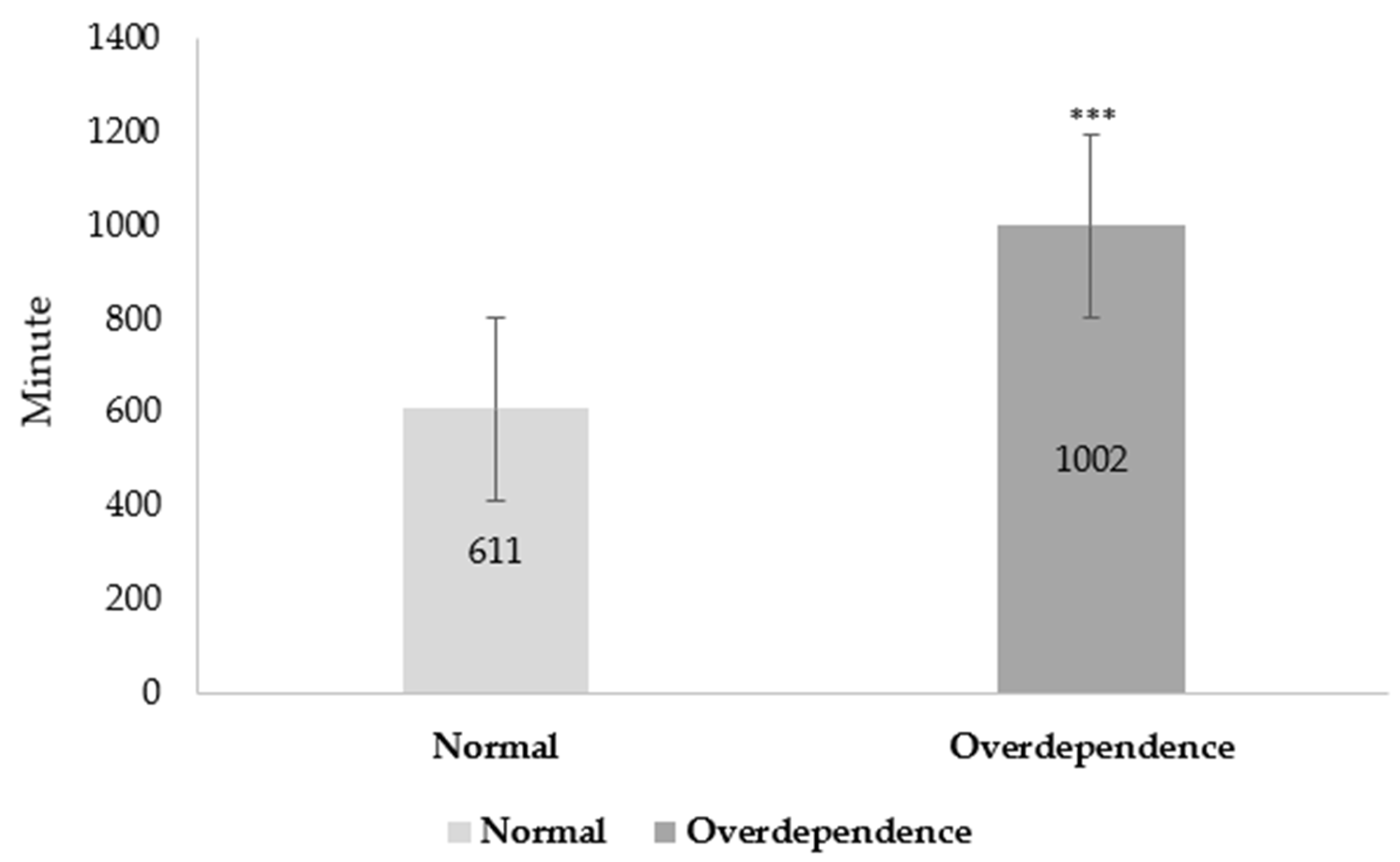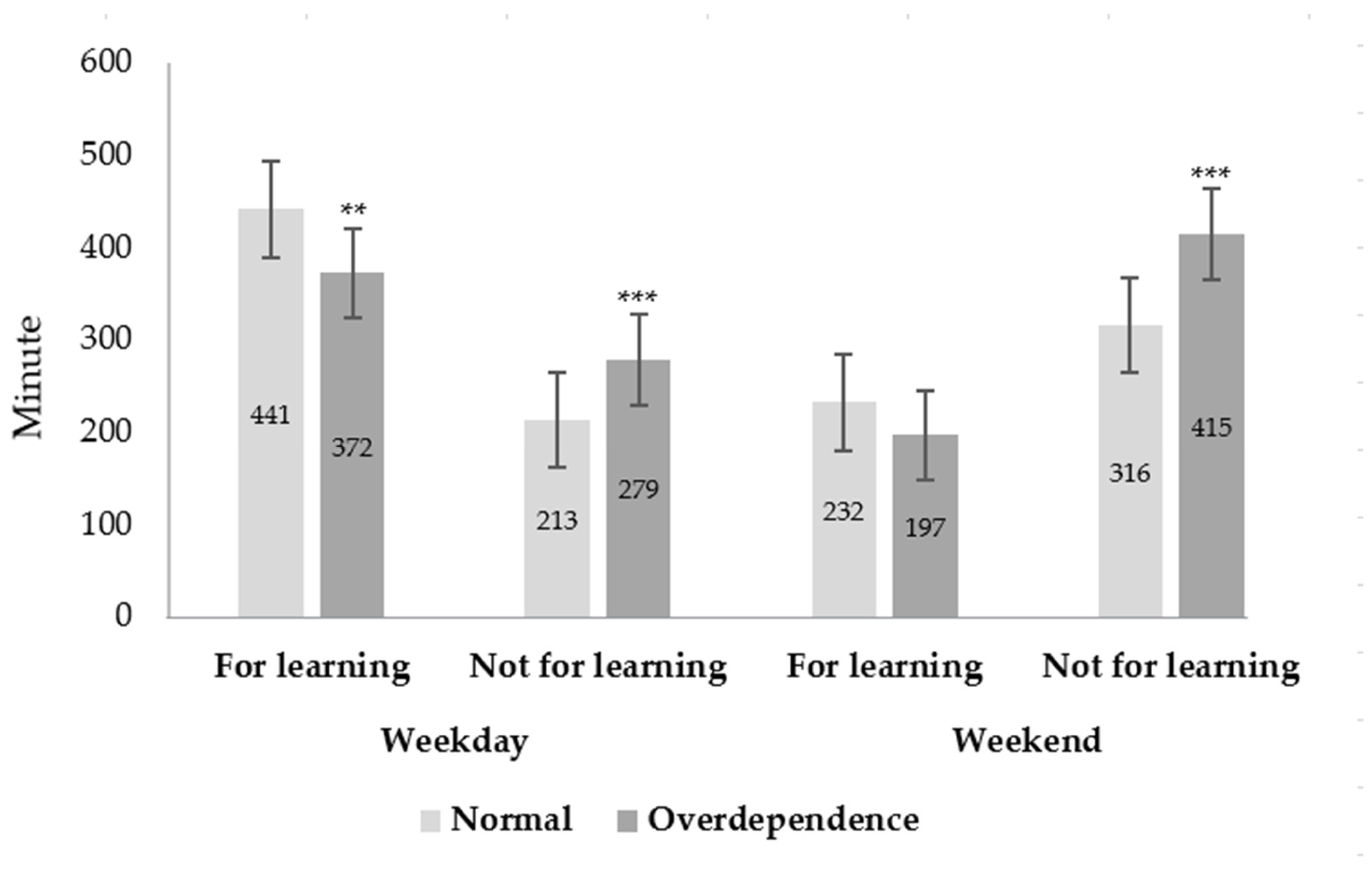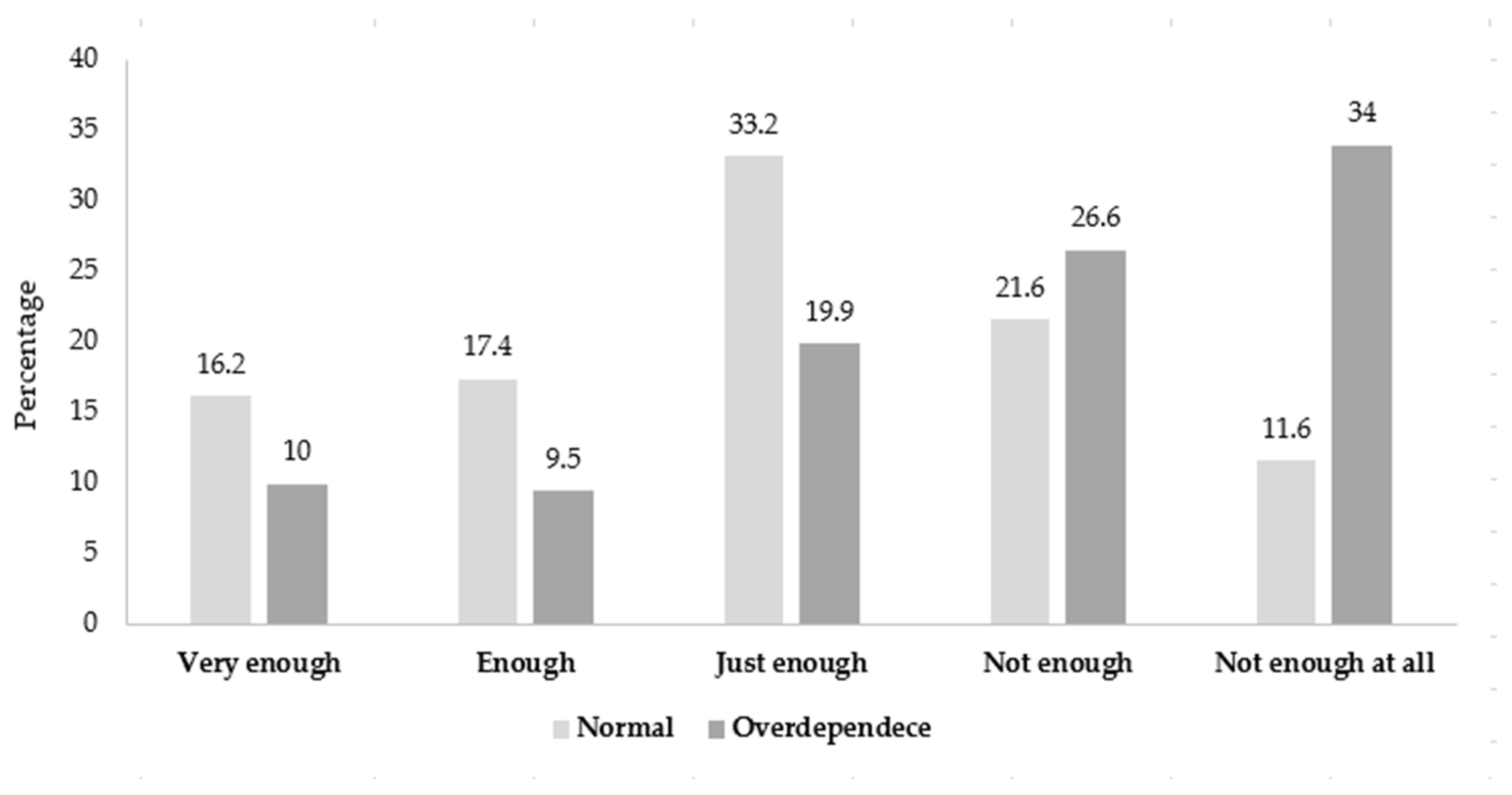Association between Physical Activity, Sedentary Behavior, Satisfaction with Sleep Fatigue Recovery and Smartphone Dependency among Korean Adolescents: An Age- and Gender-Matched Study
Abstract
1. Introduction
2. Materials and Methods
2.1. Study Participants
2.2. Anthropometrics
2.3. Measures
2.3.1. Smartphone Dependency Scale
2.3.2. Group
2.3.3. Physical Activity (PA)
2.3.4. Sedentary Behavior (SB)
2.3.5. Satisfaction with Sleep Fatigue Recovery (SSFR)
2.4. Data Analysis
3. Results
4. Discussion
5. Conclusions
Author Contributions
Funding
Institutional Review Board Statement
Informed Consent Statement
Data Availability Statement
Acknowledgments
Conflicts of Interest
References
- Statista Research Department. Number of Smartphone Subscriptions Worldwide from 2016 to 2021, with Forecasts from 2022 to 2027. 22 August 2022. Available online: https://www.statista.com/statistics/330695/number-of-smartphone-users-worldwide/ (accessed on 17 October 2022).
- Kim, D.; Lee, Y.; Lee, J.; Nam, J.K.; Chung, Y. Development of Korean Smartphone Addiction Proneness Scale for Youth. PLoS ONE 2014, 9, e97920. [Google Scholar] [CrossRef] [PubMed]
- Pew Reaserch Center. Smartphone Ownership Is Growing Rapidly Around the World, but Not Always Equally. 5 February 2019. [cited September 30]. Available online: https://www.pewresearch.org/global/2019/02/05/smartphone-ownership-is-growing-rapidly-around-the-world-but-not-always-equally/ (accessed on 30 September 2022).
- Haug, S.; Castro, R.P.; Kwon, M.; Filler, A.; Kowatsch, T.; Schaub, M.P. Smartphone use and smartphone addiction among young people in Switzerland. J. Behav. Addict. 2015, 4, 299–307. [Google Scholar] [CrossRef] [PubMed]
- Davey, S.; Davey, A. Assessment of Smartphone Addiction in Indian Adolescents: A Mixed Method Study by Systematic-review and Meta-analysis Approach. Int. J. Prev. Med. 2014, 5, 1500–1511. [Google Scholar]
- Cocoradă, E.; Maican, C.I.; Cazan, A.-M.; Maican, M.A. Assessing the smartphone addiction risk and its associations with personality traits among adolescents. Child. Youth Serv. Rev. 2018, 93, 345–354. [Google Scholar] [CrossRef]
- Cha, S.-S.; Seo, B.-K. Smartphone use and smartphone addiction in middle school students in Korea: Prevalence, social networking service, and game use. Heal. Psychol. Open 2018, 5, 2055102918755046. [Google Scholar] [CrossRef]
- Randler, C.; Wolfgang, L.; Matt, K.; Demirhan, E.; Horzum, M.B.; Beşoluk, Ş. Smartphone addiction proneness in relation to sleep and morningness–eveningness in German adolescents. J. Behav. Addict. 2016, 5, 465–473. [Google Scholar] [CrossRef]
- Liu, Q.; Huang, J.; Zhou, Z. Self-expansion via smartphone and smartphone addiction tendency among adolescents: A moderated mediation model. Child. Youth Serv. Rev. 2020, 119, 105590. [Google Scholar] [CrossRef]
- Barnes, S.J.; Pressey, A.D.; Scornavacca, E. Mobile ubiquity: Understanding the relationship between cognitive absorption, smartphone addiction and social network services. Comput. Hum. Behav. 2018, 90, 246–258. [Google Scholar] [CrossRef]
- Ministry of Science and ICT. Smartphone Addiction Risk Group. 2020-05-07. Available online: https://kosis.kr/statisticsList/statisticsListIndex.do?publicationYN=Y&statId=2006267&outLink=Y#content-group (accessed on 4 February 2022).
- Lin, Y.-H.; Lin, Y.-C.; Lee, Y.-H.; Lin, P.-H.; Lin, S.-H.; Chang, L.-R.; Tseng, H.-W.; Yen, L.-Y.; Yang, C.C.H.; Kuo, T.B.J. Time distortion associated with smartphone addiction: Identifying smartphone addiction via a mobile application (App). J. Psychiatr. Res. 2015, 65, 139–145. [Google Scholar] [CrossRef]
- Baabdullah, A.M.; Abumohssin, A.G.; Alqahtani, Y.A.; Nemri, I.A.; Sabbahi, D.A.; Alhibshi, N.M. The association between smartphone addiction and dry eye disease: A cross-sectional study. J. Nat. Sci. Med. 2019, 2, 81. [Google Scholar] [CrossRef]
- Kim, H.J.; Min, J.Y.; Min, K.B.; Lee, T.J.; Yoo, S. Relationship among family environment, self-control, friendship quality, and adolescents’ smartphone addiction in South Korea: Findings from nationwide data. PLoS ONE 2018, 13, e0190896. [Google Scholar] [CrossRef] [PubMed]
- De Pasquale, C.; Sciacca, F.; Hichy, Z. Italian Validation of Smartphone Addiction Scale Short Version for Adolescents and Young Adults (SAS-SV). Psychology 2017, 08, 1513–1518. [Google Scholar] [CrossRef]
- Kim, H. Exercise rehabilitation for smartphone addiction. J. Exerc. Rehabil. 2013, 9, 500–505. [Google Scholar] [CrossRef] [PubMed]
- Sha, P.; Sariyska, R.; Riedl, R.; Lachmann, B.; Montag, C. Linking Internet Communication and Smartphone Use Disorder by taking a closer look at the Facebook and WhatsApp applications. Addict. Behav. Rep. 2018, 9, 100148. [Google Scholar] [CrossRef] [PubMed]
- Mustafaoglu, R.; Yasaci, Z.; Zirek, E.; Griffiths, M.D.; Ozdincler, A.A.R. The relationship between smartphone addiction and musculoskeletal pain prevalence among young population: A cross-sectional study. Korean J. Pain 2021, 34, 72–81. [Google Scholar] [CrossRef] [PubMed]
- Lee, C.; Lee, S.-J. Prevalence and predictors of smartphone addiction proneness among Korean adolescents. Child. Youth Serv. Rev. 2017, 77, 10–17. [Google Scholar] [CrossRef]
- Kwon, M.; Lee, J.-Y.; Won, W.-Y.; Park, J.-W.; Min, J.-A.; Hahn, C.; Gu, X.; Choi, J.-H.; Kim, D.-J. Development and Validation of a Smartphone Addiction Scale (SAS). PLoS ONE 2013, 8, e56936. [Google Scholar] [CrossRef] [PubMed]
- Fu, L.; Wang, P.; Zhao, M.; Xie, X.; Chen, Y.; Nie, J.; Lei, L. Can emotion regulation difficulty lead to adolescent problematic smartphone use? A moderated mediation model of depression and perceived social support. Child. Youth Serv. Rev. 2019, 108, 104660. [Google Scholar] [CrossRef]
- Durak, H.Y. Investigation of nomophobia and smartphone addiction predictors among adolescents in Turkey: Demographic variables and academic performance. Soc. Sci. J. 2018, 56, 492–517. [Google Scholar] [CrossRef]
- National Intelligence Service. Smartphone Overdependence Survey. Available online: https://www.nia.or.kr/site/nia_kor/ex/bbs/View.do?cbIdx=65914&bcIdx=23109&parentSeq=23109 (accessed on 26 February 2022).
- Kim, M.-H.; Min, S.; Ahn, J.-S.; An, C.; Lee, J. Association between high adolescent smartphone use and academic impairment, conflicts with family members or friends, and suicide attempts. PLoS ONE 2019, 14, e0219831. [Google Scholar] [CrossRef]
- Lepp, A.; Barkley, J.E.; Sanders, G.J.; Rebold, M.; Gates, P. The relationship between cell phone use, physical and sedentary activity, and cardiorespiratory fitness in a sample of U.S. college students. Int. J. Behav. Nutr. Phys. Act. 2013, 10, 79. [Google Scholar] [CrossRef] [PubMed]
- Williams, D.M.; Raynor, H.A.; Ciccolo, J.T. A Review of TV Viewing and Its Association with Health Outcomes in Adults. Am. J. Lifestyle Med. 2008, 2, 250–259. [Google Scholar] [CrossRef]
- Hamilton, M.T.; Hamilton, D.G.; Zderic, T.W. Role of Low Energy Expenditure and Sitting in Obesity, Metabolic Syndrome, Type 2 Diabetes, and Cardiovascular Disease. Diabetes 2007, 56, 2655–2667. [Google Scholar] [CrossRef] [PubMed]
- Dunstan, D.W.; Barr, E.L.M.; Shaw, J.E.; Magliano, D.; Zimmet, P.Z.; Salmon, J.; Cameron, A.; Owen, N.; Healy, G.; Balkau, B. Response to Letters Regarding Article, “Television Viewing Time and Mortality: The Australian Diabetes, Obesity and Lifestyle Study (AusDiab)”. Circulation 2010, 122, e473. [Google Scholar] [CrossRef][Green Version]
- Owen, N.; Healy, G.N.; Matthews, C.E.; Dunstan, D.W. Too much sitting: The population-health science of sedentary behavior. Exerc. Sport Sci. Rev. 2010, 38, 105. [Google Scholar] [CrossRef] [PubMed]
- Rosenberg, D.E.; Norman, G.; Wagner, N.; Patrick, K.; Calfas, K.J.; Sallis, J.F. Reliability and Validity of the Sedentary Behavior Questionnaire (SBQ) for Adults. J. Phys. Act. Heal. 2010, 7, 697–705. [Google Scholar] [CrossRef] [PubMed]
- Tammelin, T.; Ekelund, U.; Remes, J.; Näyhä, S. Physical Activity and Sedentary Behaviors among Finnish Youth. Med. Sci. Sports Exerc. 2007, 39, 1067–1074. [Google Scholar] [CrossRef]
- Wacks, Y.; Weinstein, A.M. Excessive Smartphone Use Is Associated With Health Problems in Adolescents and Young Adults. Front. Psychiatry 2021, 12, 669042. [Google Scholar] [CrossRef]
- Cheung, L.M.; Wong, W.S. The effects of insomnia and internet addiction on depression in Hong Kong Chinese adolescents: An exploratory cross-sectional analysis. J. Sleep Res. 2010, 20, 311–317. [Google Scholar] [CrossRef]
- Grimaldi-Puyana, M.; Fernández-Batanero, J.M.; Fennell, C.; Sañudo, B. Associations of Objectively-Assessed Smartphone Use with Physical Activity, Sedentary Behavior, Mood, and Sleep Quality in Young Adults: A Cross-Sectional Study. Int. J. Environ. Res. Public Heal. 2020, 17, 3499. [Google Scholar] [CrossRef]
- Zhang, M.X.; Wu, A.M. Effects of smartphone addiction on sleep quality among Chinese university students: The mediating role of self-regulation and bedtime procrastination. Addict. Behav. 2020, 111, 106552. [Google Scholar] [CrossRef] [PubMed]
- Crowley, S.J.; Van Reen, E.; LeBourgeois, M.K.; Acebo, C.; Tarokh, L.; Seifer, R.; Barker, D.H.; Carskadon, M.A. A Longitudinal Assessment of Sleep Timing, Circadian Phase, and Phase Angle of Entrainment across Human Adolescence. PLoS ONE 2014, 9, e112199. [Google Scholar] [CrossRef]
- Lam, L.T. Risk Factors of Internet Addiction and the Health Effect of Internet Addiction on Adolescents: A Systematic Review of Longitudinal and Prospective Studies. Curr. Psychiatry Rep. 2014, 16, 1–9. [Google Scholar] [CrossRef] [PubMed]
- Alimoradi, Z.; Lin, C.-Y.; Broström, A.; Bülow, P.H.; Bajalan, Z.; Griffiths, M.D.; Ohayon, M.M.; Pakpour, A.H. Internet addiction and sleep problems: A systematic review and meta-analysis. Sleep Med. Rev. 2019, 47, 51–61. [Google Scholar] [CrossRef]
- Do, Y.K.; Shin, E.; Bautista, M.A.; Foo, K. The associations between self-reported sleep duration and adolescent health outcomes: What is the role of time spent on Internet use? Sleep Med. 2013, 14, 195–200. [Google Scholar] [CrossRef] [PubMed]
- Bener, A.; Yildirim, E.; Torun, P.; Çatan, F.; Bolat, E.; Alıç, S.; Akyel, S.; Griffiths, M.D. Internet Addiction, Fatigue, and Sleep Problems Among Adolescent Students: A Large-Scale Study. Int. J. Ment. Health Addict. 2019, 17, 959–969. [Google Scholar] [CrossRef]
- Kokkinos, P. Physical activity, health benefits, and mortality risk. Int. Sch. Res. Not. 2012, 2012, 718789. [Google Scholar] [CrossRef]
- Warburton, D.E.R.; Nicol, C.W.; Bredin, S.S.D. Health benefits of physical activity: The evidence. Can. Med. Assoc. J. 2006, 174, 801–809. [Google Scholar] [CrossRef]
- Penedo, F.J.; Dahn, J.R. Exercise and well-being: A review of mental and physical health benefits associated with physical activity. Curr. Opin. Psychiatry 2005, 18, 189–193. [Google Scholar] [CrossRef]
- Lang, C.; Brand, S.; Feldmeth, A.K.; Holsboer-Trachsler, E.; Pühse, U.; Gerber, M. Increased self-reported and objectively assessed physical activity predict sleep quality among adolescents. Physiol. Behav. 2013, 120, 46–53. [Google Scholar] [CrossRef]
- Tremblay, M.S.; Inman, J.W.; Willms, J.D. The Relationship between Physical Activity, Self-Esteem, and Academic Achievement in 12-Year-Old Children. Pediatr. Exerc. Sci. 2000, 12, 312–323. [Google Scholar] [CrossRef]
- Liu, M.; Wu, L.; Ming, Q. How Does Physical Activity Intervention Improve Self-Esteem and Self-Concept in Children and Adolescents? Evidence from a Meta-Analysis. PLoS ONE 2015, 10, e0134804. [Google Scholar] [CrossRef] [PubMed]
- Zhao, J.; Kong, F.; Wang, Y. Self-esteem and humor style as mediators of the effects of shyness on loneliness among Chinese college students. Pers. Individ. Differ. 2012, 52, 686–690. [Google Scholar] [CrossRef]
- Kalpidou, M.; Costin, D.; Morris, J. The Relationship Between Facebook and the Well-Being of Undergraduate College Students. Cyberpsychology Behav. Soc. Netw. 2011, 14, 183–189. [Google Scholar] [CrossRef]
- A Abbasi, G.; Jagaveeran, M.; Goh, Y.-N.; Tariq, B. The impact of type of content use on smartphone addiction and academic performance: Physical activity as moderator. Technol. Soc. 2021, 64, 101521. [Google Scholar] [CrossRef]
- Shimoga, S.V.; Erlyana, E.; Rebello, V. Associations of Social Media Use With Physical Activity and Sleep Adequacy Among Adolescents: Cross-Sectional Survey. J. Med. Internet Res. 2019, 21, e14290. [Google Scholar] [CrossRef] [PubMed]
- Samaha, M.; Hawi, N.S. Relationships among smartphone addiction, stress, academic performance, and satisfaction with life. Comput. Hum. Behav. 2016, 57, 321–325. [Google Scholar] [CrossRef]
- Kantomaa, M.T.; Stamatakis, E.; Kankaanpää, A.; Kajantie, E.; Taanila, A.; Tammelin, T. Associations of Physical Activity and Sedentary Behavior With Adolescent Academic Achievement. J. Res. Adolesc. 2015, 26, 432–442. [Google Scholar] [CrossRef]
- Janssen, I.; LeBlanc, A.G. Systematic review of the health benefits of physical activity and fitness in school-aged children and youth. Int. J. Behav. Nutr. Phys. Act. 2010, 7, 40. [Google Scholar] [CrossRef]
- Harding, S.K.; Page, A.S.; Falconer, C.; Cooper, A.R. Longitudinal changes in sedentary time and physical activity during adolescence. Int. J. Behav. Nutr. Phys. Act. 2015, 12, 44. [Google Scholar] [CrossRef]
- Wood, A.W.; Loughran, S.P.; Stough, C. Does evening exposure to mobile phone radiation affect subsequent melatonin production? Int. J. Radiat. Biol. 2006, 82, 69–76. [Google Scholar] [CrossRef] [PubMed]
- Tarokh, L.; Saletin, J.M.; Carskadon, M.A. Sleep in adolescence: Physiology, cognition and mental health. Neurosci. Biobehav. Rev. 2016, 70, 182. [Google Scholar] [CrossRef] [PubMed]
- Park, S. Associations of physical activity with sleep satisfaction, perceived stress, and problematic Internet use in Korean adolescents. BMC Public Health 2014, 14, 1143. [Google Scholar] [CrossRef] [PubMed]
- Kim, J.-H. Factors Associated with Smartphone Addiction Tendency in Korean Adolescents. Int. J. Environ. Res. Public Health 2021, 18, 11668. [Google Scholar] [CrossRef]



| Variable | Normal (n = 241) | Overdependence (n = 241) | ||||
|---|---|---|---|---|---|---|
| No. (%) | Mean ± SD | No. (%) | Mean ± SD | |||
| Gender | Male | 117 (48.5) | 116 (48.1) | |||
| Female | 124 (51.5) | 125 (51.9) | ||||
| Age (year) | 12 year | 11 (4.6) | 11 (4.6) | |||
| 13 year | 26 (10.8) | 26 (10.8) | ||||
| 14 year | 36 (14.9) | 36 (14.9) | ||||
| 15 year | 52 (21.6) | 52 (21.6) | ||||
| 16 year | 35 (14.5) | 35 (14.5) | ||||
| 17 year | 56 (23.2) | 56 (23.2) | ||||
| 18 year | 25 (10.4) | 25 (10.4) | ||||
| Anthropometrics | Male | Age (year) | 15.56 ± 1.7 | 15.58 ± 1.7 | ||
| Height (cm) | 171.9 ± 8.0 | 172.1 ± 8.6 | ||||
| Weight (kg) | 64.5 ± 14.2 | 65.9 ± 14.2 | ||||
| BMI (kg·m−2) | 21.8 ± 4.2 | 22.2 ± 4.2 | ||||
| Female | Age (year) | 15.29 ± 1.7 | 15.27 ± 1.7 | |||
| Height (cm) | 161.3 ± 5.3 | 161.3 ± 5.1 | ||||
| Weight (kg) | 52.9 ± 8.6 | 53.9 ± 8.3 | ||||
| BMI (kg·m−2) | 20.3 ± 2.9 | 20.7 ± 2.8 | ||||
| Total | Age (year) | 15.42 ± 1.7 | 15.42 ± 1.7 | |||
| Height (cm) | 166.4 ± 8.5 | 166.5 ± 8.8 | ||||
| Weight (kg) | 58.6 ± 13.0 | 59.7 ± 13.0 | ||||
| BMI (kg·m−2) | 21.0 ± 3.6 | 21.4 ± 3.6 | ||||
| Variable | B | S.E. | Sig. | OR (95% CI) | 95% Confidence Interval for Exp (B) | ||
|---|---|---|---|---|---|---|---|
| Lower Bound | Upper Bound | ||||||
| Number of light PA days (≥60 min per day) | No participation in the last 7 days | 1 [reference] | |||||
| 1 day | −0.03 | 0.35 | 0.92 | 0.97 | 0.49 | 1.90 | |
| 2 days | −0.52 | 0.40 | 0.20 | 0.59 | 0.27 | 1.31 | |
| 3 days | 0.07 | 0.42 | 0.87 | 1.07 | 0.47 | 2.46 | |
| 4 days | −0.38 | 0.53 | 0.48 | 0.69 | 0.24 | 1.93 | |
| 5 days | −0.71 | 0.61 | 0.24 | 0.49 | 0.15 | 1.61 | |
| 6 days | −0.61 | 0.83 | 0.46 | 0.54 | 0.11 | 2.74 | |
| Every day for the last 7 days | −1.54 | 0.59 | 0.01 * | 0.21 | 0.07 | 0.69 | |
| Number of MVPA days | No participation in the last 7 days | 1 [reference] | |||||
| 1 day | 0.53 | 0.36 | 0.14 | 1.70 | 0.84 | 3.42 | |
| 2 days | 0.28 | 0.38 | 0.47 | 1.32 | 0.62 | 2.80 | |
| 3 days | 0.37 | 0.44 | 0.39 | 1.45 | 0.62 | 3.40 | |
| 4 days | 0.80 | 0.59 | 0.17 | 2.23 | 0.70 | 7.06 | |
| 5 days or more | 1.41 | 0.55 | 0.01 * | 4.10 | 1.39 | 12.13 | |
| No participation in the last 7 days | 1 [reference] | ||||||
| Number of strength training days | 1 day | 0.95 | 0.40 | 0.02 * | 2.60 | 1.18 | 5.72 |
| 2 days | 0.18 | 0.44 | 0.69 | 1.19 | 0.50 | 2.84 | |
| 3 days | 0.14 | 0.60 | 0.82 | 1.15 | 0.36 | 3.70 | |
| 4 days | 0.04 | 0.41 | 0.93 | 1.04 | 0.46 | 2.34 | |
| Not enough at all | 1 [reference] | ||||||
| Satisfaction with sleep fatigue recovery | Not enough | 0.73 | 0.32 | 0.02 * | 2.07 | 1.11 | 3.87 |
| Just enough | 1.61 | 0.32 | 0.00 *** | 4.99 | 2.66 | 9.34 | |
| Enough | 1.23 | 0.38 | 0.00 ** | 3.43 | 1.63 | 7.23 | |
| Very enough | 1.23 | 0.38 | 0.00 ** | 3.43 | 1.63 | 7.24 | |
Publisher’s Note: MDPI stays neutral with regard to jurisdictional claims in published maps and institutional affiliations. |
© 2022 by the authors. Licensee MDPI, Basel, Switzerland. This article is an open access article distributed under the terms and conditions of the Creative Commons Attribution (CC BY) license (https://creativecommons.org/licenses/by/4.0/).
Share and Cite
Hwang, I.-W.; Choe, J.-P.; Park, J.-H.; Lee, J.-M. Association between Physical Activity, Sedentary Behavior, Satisfaction with Sleep Fatigue Recovery and Smartphone Dependency among Korean Adolescents: An Age- and Gender-Matched Study. Int. J. Environ. Res. Public Health 2022, 19, 16034. https://doi.org/10.3390/ijerph192316034
Hwang I-W, Choe J-P, Park J-H, Lee J-M. Association between Physical Activity, Sedentary Behavior, Satisfaction with Sleep Fatigue Recovery and Smartphone Dependency among Korean Adolescents: An Age- and Gender-Matched Study. International Journal of Environmental Research and Public Health. 2022; 19(23):16034. https://doi.org/10.3390/ijerph192316034
Chicago/Turabian StyleHwang, In-Whi, Ju-Pil Choe, Jeong-Hui Park, and Jung-Min Lee. 2022. "Association between Physical Activity, Sedentary Behavior, Satisfaction with Sleep Fatigue Recovery and Smartphone Dependency among Korean Adolescents: An Age- and Gender-Matched Study" International Journal of Environmental Research and Public Health 19, no. 23: 16034. https://doi.org/10.3390/ijerph192316034
APA StyleHwang, I.-W., Choe, J.-P., Park, J.-H., & Lee, J.-M. (2022). Association between Physical Activity, Sedentary Behavior, Satisfaction with Sleep Fatigue Recovery and Smartphone Dependency among Korean Adolescents: An Age- and Gender-Matched Study. International Journal of Environmental Research and Public Health, 19(23), 16034. https://doi.org/10.3390/ijerph192316034








